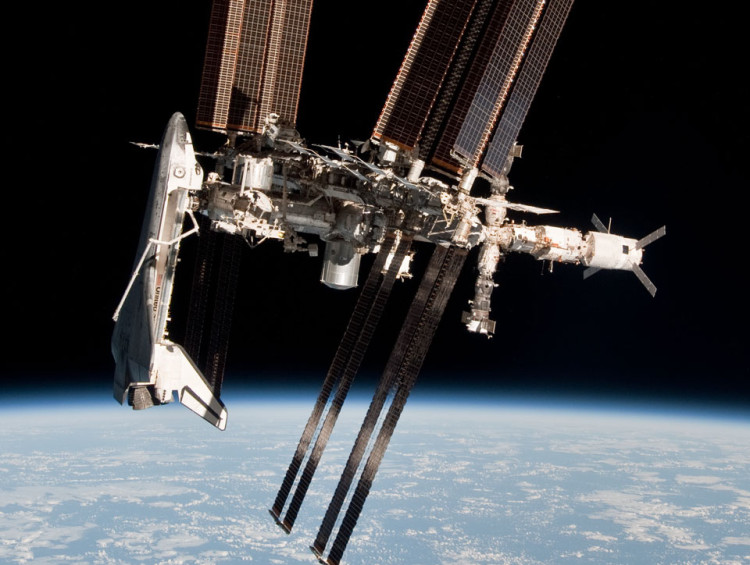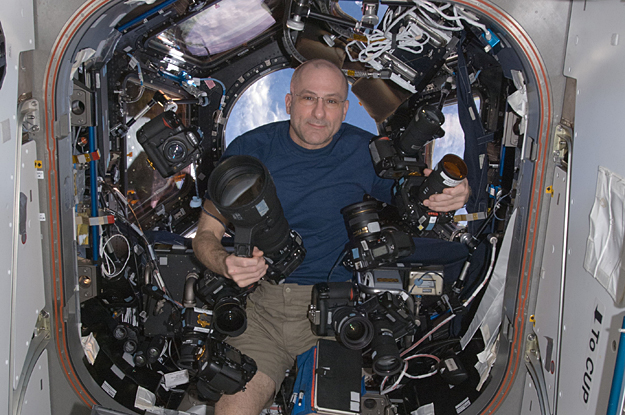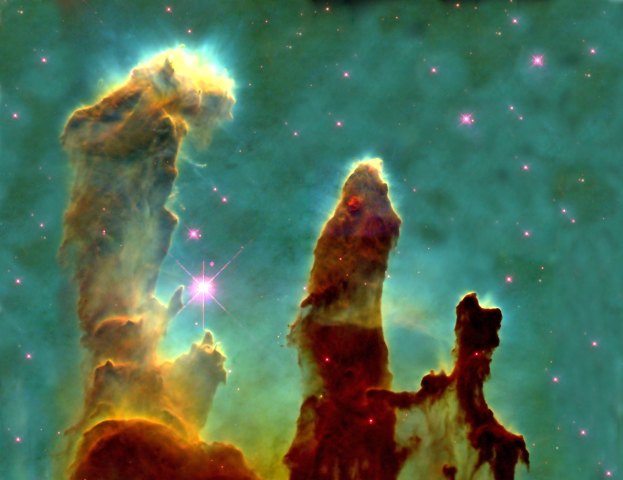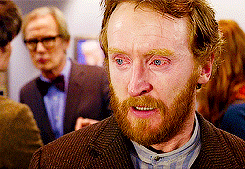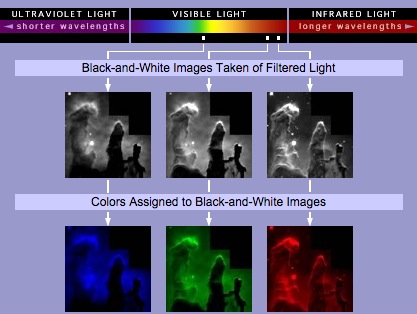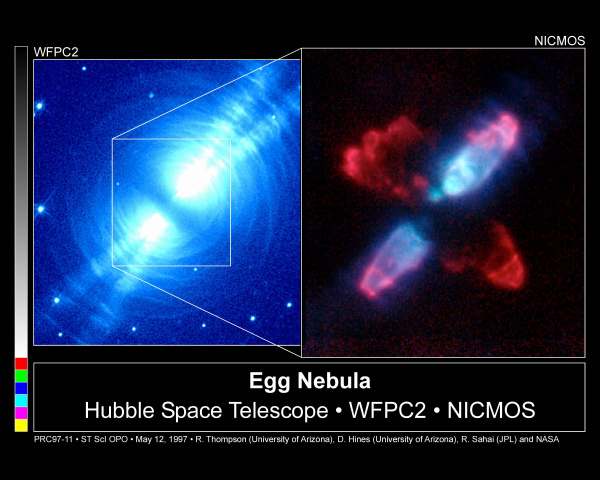Hey there! Pull up a chair—we need to have a talk. It’s about all those pictures in your browser history. We know what you’ve been looking at, and there’s nothing wrong with it, but we wanted to talk to you about how realistic it is and make sure you understand it’s not entirely accurate. Yes. We’re talking about your spaceporn.
Aside from the wonderful, more traditionally produced images that we’ve been getting from astronauts aboard the International Space Station, pretty much the best source of space imagery has long been the Hubble Space Telescope, so that’s the process we’ll use as an example. The Hubble launched in 1990 and has been bringing us beautiful images of space ever since, affectionately dubbed “spaceporn” by the Internet.
So what’s the difference that makes the images from the ISS more “traditional” than Hubble’s? Well, here’s NASA astronaut Don Pettit posing with the some of the cameras the astronauts use aboard the ISS:
You’ll notice that these cameras aren’t too different from what your aunt carries around at parties while you’re busy throwing Instagram filters on things on your phone. Meanwhile, every image that comes from the Hubble is a composite of several different black and white images from light sensitive instruments that are put together with filters of different colors applied to eventually come out with things that look like this:
Amazing, right? Each corner of the Universe is truly a beautiful and unique snowflake with untold visual wonders that would make Van Gogh weep.
Not so fast—let’s back up and first understand how that image was physically made.
When you look at a Hubble image, what you’re really seeing is a visualization of scientific data. Like computer monitors and TVs, Hubble images mimic the human eye’s red, green, and blue color receptors by combining those three colors to generate approximately 16.7 million individual color values—pretty much any color the human eye can see.
This is done by breaking down the light coming into the telescope with color filters to produce black and white images. Like so:
Three different filters were used to capture small slivers of the visible light spectrum by Hubble’s imaging equipment in black and white representations of light and dark within each filter’s range of light wavelengths. Then, the red, green, and blue colors were assigned by a technician in imaging software after the fact. As you can see, green visible light was assigned a blue hue, while two sections of red light were assigned green and red.
Here, take a time-lapse peek behind the curtain at how an even more complicated link of delicious space-sausage is made (with a genius choice of music accompaniment):
But let’s get back to that image of the Eagle Nebula and why the technician would pick out specific colors of visible light and make them the wrong colors. In this case, the colors were chosen to bring out a higher level of detail in the image:
These color reassignments enhance the level of detail visible in the image, because otherwise the red light from hydrogen and that from sulfur would be hard to tell apart.
In the final image, the blue-green haze indicates light from hydrogen and oxygen surrounding the dark columns. The columns display reddish highlights identifying light from sulfur.
So the image above isn’t necessarily what we’d see if we passed by that region of space in a TARDIS spaceship, as Hubble’s website points out:
The colors in Hubble images, which are assigned for various reasons, aren’t always what we’d see if we were able to visit the imaged objects in a spacecraft. We often use color as a tool, whether it is to enhance an object’s detail or to visualize what ordinarily could never be seen by the human eye.
We use color:
- To depict how an object might look to us if our eyes were as powerful as Hubble
- To visualize features of an object that would ordinarily be invisible to the human eye
- To bring out an object’s subtle details.
In the latter two cases, the coloring is a judgment call by the person putting the image together, and it’s just as much an art as it is science.
Yes, some of the amazing space images you’ve been salivating over are of things you wouldn’t actually even be able to see with your own eyes. Hubble sometimes uses its filters to capture ultraviolet and infrared light, which human beings can’t see at all. Here’s a picture of something that, to our eyes, looks much different:
The color image of the Egg Nebula on the right is made entirely from different sections of the infrared light spectrum reassigned to red, green, and blue in the same way as the Eagle Nebula’s visible light. The left hand side is a visible light representation of the same image, which just appears bright and blue to the human eye. The image on the right is certainly more useful to science, but it paints a confusing picture of what the Universe looks like.
But wait! Before you go storming off thinking everything you know is a lie, demanding your tax dollars back from NASA, or some third perfectly reasonable reaction to these methods, take a minute to consider that for all its complicated processes, this isn’t as different from traditional photography as it sounds.
All photography is a representation of data taken in by the camera’s lens, and none of it can ever truly look exactly the same as human beings see it with their eyes. Incidentally, that’s kind of why I fly into a blind rage when people assume that an Instagram pic without a filter or a photo untouched by Photoshop is automatically more realistic—sometimes, cameras do a poor job of capturing the way things actually look.
It’s even true of the most ancient and derelict of photographic techniques: film. Even when developing a black and white picture in the dark ages in a darkroom, the contrast and brightness is all up to the photographer and even depends on the kind of photo paper used. Photographs made using the same exact negative can look drastically different depending on how they’re developed.
We often forget this, because for most people, the process is automatic and no longer done by hand. When you take a digital photo with your phone, its image sensors and software work together to produce an image that it thinks is closest to what you wanted, but making adjustments afterwards can often get you a closer representation of what you actually saw. Whenever you last took film to a 1-hour photo to get it developed, the settings on their developing machines affected how your pictures came out in ways you might not even have noticed.
So does the Universe always look exactly like what we see when a new Hubble image is released? Not to us, no, but it’s still a very real representation of what’s out there all the same. Remember, we humans don’t even have exceptionally good color vision. Maybe the Hubble’s images are intended to be viewed by our eventual overlords the mantis shrimp, which can see several types of light that humans can’t and will one day punch us into submission.
But again, not all images of space are made this way. It just takes really sophisticated equipment to get images of things that are so far away, which is usually left to scientists and rarely for commercial purposes. Our Universe is still a beautiful place, and here’s some proof with a jaw-dropping Vine from the ISS:
So go ahead. Explore your spaceporn curiosities, but keep your expectations in check. When you see a picture, take a minute to track it back to its original posting and read the caption to find out just what it is you’re seeing depicted by the colors in the images. That way, you’ll get an even deeper appreciation for all the amazing things that are out there in the Universe.
(video and all spaceporn images via NASA)
- ESA’s Rosetta has been sending back images of its comet home
- Here are some Hubble images of a star’s birth
- By the way, the geckos on that Russian sex satellite all died, sadly
Are you following The Mary Sue on Twitter, Facebook, Tumblr, Pinterest, & Google +?



